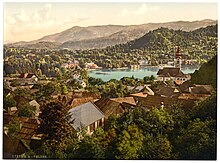Bled (pronounced [ˈbleːt] ; German: Veldes, in older sources also Feldes) is a town on Lake Bled in the Upper Carniolan region of northwestern Slovenia. It is the administrative seat of the Municipality of Bled. It is most notable as a popular tourist destination in the Upper Carniola region and in Slovenia as whole, attracting visitors from abroad too.
 Lake Bled and Bled Castle by Valvasor, 17th century
Lake Bled and Bled Castle by Valvasor, 17th century Panorama of Bled, 18th century
Panorama of Bled, 18th century Panorama of Bled, late 19th century
Panorama of Bled, late 19th centuryA settlement area since Mesolithic times, the present-day locality probably arose about 600 during the Slavic settlement of the Eastern Alps. After the Slavic principality of Carantania was conquered by Frankish forces in 788, the area came under Bavarian influence.
Feudal estateGerman King Henry II ceded ownership of the area in 1004 to Albuin, Bishop of Brixen as a sign of gratitude for the assistance the Church was giving to the king in his attempt to strengthen imperial rule in that part of northern Italy. In 1011, Henry II signed another deed of donation that added the castle and an area of land the size of thirty king's farms. That area, between the Sava Bohinjka and the Sava Dolinka, became known as the Lordship of Veldes (German: Herrschaft Veldes). These donations marked a turning point in the history of Bled and, for the following 800 years, the area remained under the sovereignty of the prince-bishops of Brixen.
The bishops very seldom visited their remote possession 300 km away. Initially, the lordship was administered by ministeriales (bonded knights), castellans, and castle staff in accordance with feudal practices, but in the middle of the 14th century the prince-bishops decided instead to lease the estate. Under one of the 16th-century lessees, Bled Castle became a Protestant stronghold for a time. When the leasehold era came to an end, the prince-bishops began to appoint governors to manage their distant lordship. Until the middle of the 18th century, those administrators were exclusively aristocratic, but later they included non-nobles.
In 1803, Brixen's rule came to an end when the prince-bishopric was secularized in the course of the German Mediatization. Bled then came under Austrian sovereignty but in 1808, along with Carniola, it was included in the Napoleonic Illyrian Provinces. It returned under Austrian sovereignty in 1813, and in 1838 the Austrian Emperor returned Bled to the bishops of Brixen as a private estate. With the abolition of the feudal system in 1848, Bled ceased to have the characteristics of a feudal economy and from then on it experienced several changes in ownership, including industrialists and a bank.[1][2]
After the dissolution of Austria-Hungary in 1918, Bled and the rest of Carniola came under the rule of the Kingdom of Yugoslavia and became a summer domicile of the ruling House of Karađorđević, a tradition that Yugoslav leader Josip Broz Tito continued when he built his residence here in 1947.
Modern settlementToday's town began to form in the mid-19th century from the villages of Grad, Mlino, Rečica, Zagorice, and Želeče, which were encircling the lake. At that time, farmers started to sell the land along the eastern lakeshore to wealthy individuals for their villas, and the villages of Grad, Zagorice, and Želeče began to merge. Bled was officially recognised as a town in 1960.






























Add new comment